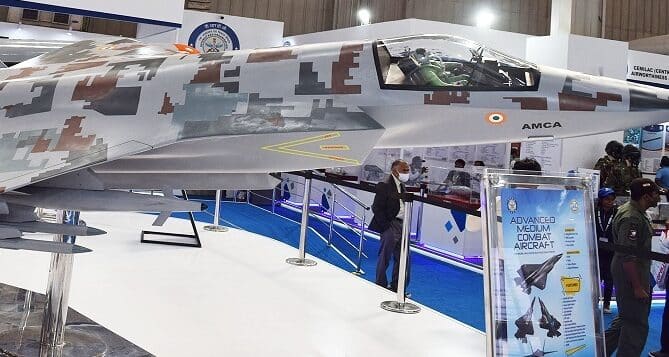Aerospace
AMCA Project’s Critical Funding Hurdles Threaten India’s Fighter Jet Ambitions

The AMCA (Advanced Medium Combat Aircraft) project is highly anticipated in the realm of Indian defense, primarily because India currently lacks advanced fighter jets beyond the Rafale aircraft.
The country does not possess a 5th generation fighter jet, making the AMCA project crucial. While India received proposals from both the United States and Russia to use their fighter jets, the decision was made to develop their own aircraft, minimizing reliance on foreign models.
AMCA program may experience further delays
Nevertheless, the AMCA program may experience further delays due to pending funding clearance. The Indian Defense Research and Development Organisation (DRDO) is struggling to obtain approval from a government committee for this critical project, which is facing regulatory obstacles.
The AMCA represents a cutting-edge stealth fighter, and a prototype is anticipated by 2026. However, they require permission from the Cabinet Committee on Security (CCS), which has been on hold for the past six months, causing concern within the defense community.
Initially, the estimated budget for the AMCA project was $2 billion. However, in 2023, an additional $5 billion was allocated for engine development, and $1.8 billion for the aircraft prototype. Currently, the Tejas Mark2 is preparing for its rollout from the factory, with plans for its debut in 2024 and full-scale production by 2026.
GE has also received approval and intends to establish engine manufacturing in India for the Tejas aircraft. The progress on the Tejas Mark2 has led to a temporary halt in the AMCA project due to funding clearance issues.
AMCA is divided into two phases
The development of the AMCA is divided into two phases. Phase 1 will result in the AMCA Mk-1, powered by the US GE-414 engine. Phase 2 will lead to the AMCA Mk2, equipped with an advanced and more potent engine developed in collaboration with an as-yet-undetermined foreign partner.
According to some sources, the AMCA is classified as a 4.5 generation fighter jet, lacking some features typically found in 5th generation fighter jets, such as full stealth capability, advanced avionics, radar features, and engine capacity. Nonetheless, it boasts two engines and an internal bay for carrying weapons.
The AMCA Mk-1 features limited stealth and draws inspiration from the F-35, which exhibits a reduced rear aspect radio frequency signature but retains suppressed infrared (IR) characteristics.

Aerospace
Boeing Transfers Rocket Stage to NASA, Paving Way for Human Moon Mission

Boeing has achieved a significant milestone by providing NASA with the second core stage of the Space Launch System (SLS) rocket.
This crucial component, crafted at NASA’s Michoud Assembly Facility (MAF), is set to propel the Artemis II crew into lunar orbit, marking humanity’s return to deep space after a 50-year hiatus.
The monumental Boeing-built rocket stage, the largest element of the Artemis II mission, will embark on a journey aboard the Pegasus barge, traveling 900 miles to NASA’s Kennedy Space Center.
Comparison of two legendary aircraft B777x vs B747 aircraft:Click here
Upon arrival, it will be meticulously integrated with other essential Artemis II components, including the upper stage, solid rocket boosters, and NASA’s Orion spacecraft within the iconic Vehicle Assembly Building. This intricate integration process is a vital step toward the eagerly anticipated Artemis II launch, slated for 2025.
“Boeing-built products helped land humankind on the moon in 1969, and we’re proud to continue that legacy through the Artemis generation,” remarked Dave Dutcher, vice president and program manager for Boeing’s SLS program. “Together, with NASA and our industry partners and suppliers, we are building the world’s most capable rocket and paving the way to deep space through America’s rocket factory in New Orleans.”
NASA, Lockheed Martin Reveal X-59 Quiet Supersonic Aircraft:Click here
The delivery of Core Stage 2 marks a significant achievement in the evolution of the SLS rocket. Towering over 200 feet and powered by four RS-25 engines, this core stage, coupled with two solid-fueled booster rockets, will generate a staggering 8.8 million pounds of thrust. This immense power is crucial to launching Artemis II and future missions into the vast expanse of space.
The SLS rocket stands unparalleled in its capability to transport both crew and substantial cargo to the moon and beyond in a single launch. Its extraordinary capacity will facilitate the delivery of human-rated spacecraft, habitats, and scientific missions to destinations including the moon and Mars, ushering in a new era of space exploration.
-

 Travel1 week ago
Travel1 week agoAir India to Expand US Operations with Three New Routes After a Decade
-

 Travel2 weeks ago
Travel2 weeks agoWhy We Should Avoid These Stamps in a Passport
-

 Airlines1 month ago
Airlines1 month agoInvestigations Reveal Fake Chinese Titanium in Boeing and Airbus Jets
-

 Tech4 weeks ago
Tech4 weeks agoChina’s CATL Plans 1,800-Mile Electric Plane Launch by 2027
-

 Airport3 days ago
Airport3 days agoTop 10 Largest Airports in the World by Size
-

 Aerospace4 weeks ago
Aerospace4 weeks agoChina’s Fighter Jets Turn Wings into Autonomous Drones
-

 Airlines4 days ago
Airlines4 days agoAir India Rolls Out A350s for Delhi-New York JFK and Newark Routes
-

 Defence3 weeks ago
Defence3 weeks agoBoeing Enhances Chinook with New Engines and Block II Upgrades at $96 Million







